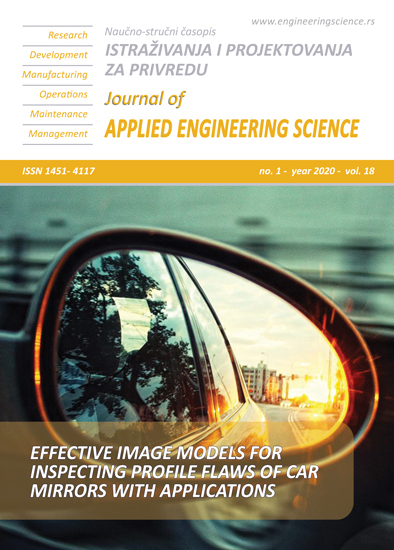THE EDDY CURRENT DIAGNOSTICS METHOD FOR THE PLASTICALLY DEFORMED AREA SIZES EVALUATION IN NON-MAGNETIC METALS
Abstract
The aim of this research is to reveal and determine the sizes of plastically deformed areas in metallic non-magnetic materials with the eddy current method. The manuscript contains computational studies to assess the feasibility of using the eddy current method to determine the size of the plastically deformed areas in the metal. The authors developed a two-dimensional mathematical model of the interaction of the electromagnetic field with the control object. The model included poly-harmonic field excitation in a locally deformed plate, and the deformation was modeled in the form of plastically deformed areas under the indents obtained by the ball indentation. The developed model helped to establish the correlation dependencies and linked the informative parameters of the eddy current method with the size of the metal’s plastically deformed zone. The authors obtained the calibration curve for copper, the values of which allowed to determine the factual sizes of the plastically deformed area.
References
Jia, L.J., Ge, H. (2019) Stress–strain behaviors in large plastic strain ranges under monotonic loading, Springer Tracts in Civil Engineering, 13-23.
Bhandari, R., Biswas, P., Mondal, M.K., Mandal, D. (2018). Finite element analysis of stress–strain localization and distribution in Al-4.5Cu-2Mg alloy, Transactions of Nonferrous Metals Society of China (English Edition), vol. 28, no. 6, 1200-1215.
Shuvalov, A.N., Emeliyanov, O.V., Bultykov, A.V., Prokić, M. (2016) Stress intensity factor in welded joints out of double angles in lattice steel structures, Journal of Applied Engineering Science, vol. 14, no. 2, 285-289.
Yao, K., Wu, L.B., Wang, Y.S. (2019). Nondestructive Evaluation of Contact Damage of Ferromagnetic Materials Based on Metal Magnetic Memory Method, Experimental Techniques, vol. 43, no. 3, 273-285.
Habibalahi, A., Habibalahi, M., Samadian, K. (2018). Pulsed eddy current applied to measure residual stress in welding, Journal of Testing and Evaluation, vol. 46, no. 6, 20160504.
Lunin, V.P., Chernov, L.A., Slavinskaya, E.A., Terekhin, I.V., Barat, V.A. (2016). The method of controlling the changes in electrical conductivity of the inner layers of non-magnetic metals and the way of its performing. The RF Patent No. 2597960. Bulletin 2016. No. 26
Svatos, J, Pospisil, T., Vedral, J. (2018). Application of poly-harmonic signals to eddy-current metal detectors and to advanced classification of metals, Metrology and measurement systems, vol. 25, no. 2, 387 – 402.
Breumier, S., Villani, A., Maurice, C., Lévesque, M., Kermouche, G. (2019). Effect of crystal orientation on indentation-induced residual stress field: Simulation and experimental validation, Materials and Design, vol. 169, no. 5, 107659.
Pero, R., Maizza, G., De Marco, F., De Fazio, P., Montanari, R, Ohmura, T. (2019). Determination of the yield radius and yield stress in 2198-T3 aluminum alloy by means of the dual-scale instrumented indentation test, Materials Transactions, vol. 60, no. 8, 1450-1456.
Chaudhri, M.M. (1996). Subsurface plastic strain distribution around spherical indentations in metals, Philosophical Magazine A: Physics of Condensed Matter, Structure, Defects and Mechanical Properties, vol. 74, no. 5, 1213-1224.
Matyunin, V.M., Marchenkov, A.Yu., Terent’ev E.V., Demidov, A.N. (2016). Substantiation of the ratio of the sample thickness to the indentation depth in hardness measurements, Russian metallurgy (Metally), no. 13, 47-50.
Matyunin, V.M., Kazantsev, A.G., Marchenkov, A.Yu. (2018). Distribution of stresses and deformations in the deformed metal volume at indenting of a spherical indenter, Inorganic materials, vol. 54, no. 15, 49-54.
Chaudhri, M.M. (1998). Subsurface strain distribution around Vickers hardness indentations in annealed polycrystalline copper, Scripta Materialia, vol. 46, no. 9, 3047-3056.

